If you’ve ever looked at images of vintage barber shops, the chances are good that you’ve seen one of these vintage barber chairs before. In 1906, a merchant and artist by the name of Ernest Koken built the first hydraulic vintage barber chair. These vintage Koken barber chairs date back to that year.
Ernest Koken was already well known to barber shops as a provider of barbershop basics, and when he debuted his original design, these chairs proved such a triumph that they are still generally recognized as an important feature of a classic vintage barber shop.
In today’s world, antique Koken barber chairs may fetch prices in the thousands of dollars when put up for auction.
More than simply a useful piece of furniture, ancient Koken barber chairs are truly objects of art. Because of the magnificent materials and workmanship of these chairs, investors now seek them out and spend hundreds of dollars for them.
Table of Contents
History of Antique Koken Barber Chairs
The Koken Barber’s Supply Company produced hundreds of these chairs for barbershops all throughout the United States in the late 1800s and early 1900s. Koken was not just the leading barber supply business in the United States; it was also the leading manufacturer of barber chairs.
It had its headquarters in St. Louis, Missouri. Earnest E. Koken, who started the firm, was awarded patents for a number of significant barber supply goods throughout his lifetime.
In the year 1881, Koken invented and patented a reclining barber chair, which made it simpler for barbers to shave their customers. Between the years 1885 and 888, Koken was granted patents for rotating and reclining barber chairs. These chairs offered barbers an even greater degree of versatility when it came to serving clients.
In 1892, the firm received a patent for a hydraulically driven barber chair, which would later become Koken’s claim to fame. 1926 was the year that the business established the Koken Foundry, which enabled it to produce up to one hundred chairs on a daily basis.
The Koken Barber’s Supply Company was unable to survive the 1950s and went out of business. A Japanese firm that produced barber supplies under the name Koken at one point in time was located in Japan.
Evolution of Antique Barber Chairs
The First Few Years
Ernest Koken was a young man who was both imaginative and hard-working. Koken was born in Germany but grew up in St. Louis, Missouri.
Young Ernest dropped out of school and immediately began working to support his mother and siblings when his father passed away suddenly. In the beginning, he was successful as an artist and producer.
He created hand-decorated fine porcelain shaving mugs, mirrors, razors, strops, clippers, and other equipment, and he sold them to neighborhood barber shops. Soon, though, he found himself thinking about engineering, which was his biggest interest.
In his leisure time, Ernest started working on prototypes for various products, and ultimately he came up with a brilliant reclining chair that was not only more comfortable but also handier for both the barber and the client. This made the basis for earlier models of barber chairs. However, the most significant advances in his work are still to come.
Vintage Koken Barber Chair Equipped with Hydraulics
Koken was encouraged to continue refining and developing the barber chair since he had already received a patent for his original and creative reclining chair design and because there was a growing demand for his invention.
In the year 1900, he had the inspiration for what would turn out to be his most groundbreaking invention: a hydraulically driven chair that was outfitted with a joystick-style lever that gave barbers the ability to rapidly and simply control all of the chair’s motions.
Koken also received patents for these developments, and the company later merged them to produce the Koken Hydraulic Barber Chair, which was an instant hit with barber shops all throughout the United States and abroad.
An Expanding Empire
Although Ernest Koken suffered from heart failure and died away in 1909, his son Walter led the Koken Barber’s Supply company to become the most successful and largest barber supply company in the United States after his father’s passing.
The firm proceeded to improve and broaden its product range, and as a result, it was finally granted patents for designs connected to chairs used in beauty parlors, chiropodists’ offices, and other medical practices.
Even further, Walter Koken unearthed his father’s ideas for an internal combustion engine, which he had built in an effort to compete with Henry Ford’s engine. However, the plans were ultimately unsuccessful and were never put into production.
A Lasting Legacy
The Koken Barber’s Supply company was a leading barber supply company in the United States up until the 1950s. At that time, the company was driven into bankruptcy due to the advent of a number of rivals that offered products at cheaper prices as well as a gradually dwindling barber sector.
The beginning of the 1960s brought about more difficulties for the once-thriving corporation, as did the widespread fashion trend for haircuts that included longer hair and greater creativity.
By 1970, the Koken Barber’s Supply Company had been acquired by the Takara Belmont Company of Japan, which then integrated several of the company’s ideas into its own designs after also purchasing a number of the company’s patents.
The Koken Brand Stamp
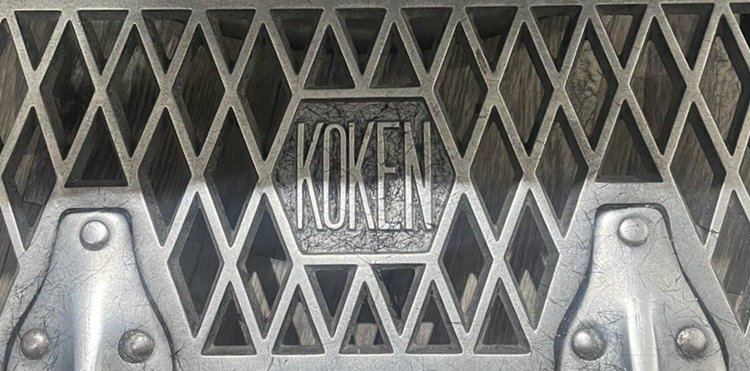
Koken is still considered an important and recognized figure in the field of barbering, despite the fact that it has been well over a century since Ernest Koken introduced his first groundbreaking innovations.
Antique chairs have become very desirable on the collectibles market, and Takara Belmont continues to create heritage chairs carrying the Koken trademark. Ernest Koken’s early designs and patents continue to serve as the foundation for a significant number of barber chairs that are manufactured to this day. In 1975, Koken was inducted into the Barber Hall of Fame.
Identification of An Antique Koken Barber Chair
Because the manufacturer branded the majority of their products with their name, it is possible to recognize a Koken barber chair. Conduct a search for the term “Koken” among the metal components of the chair.
You can better estimate the worth of a chair if you are familiar with its model, the year it was manufactured, and its serial number.
Components of the chair
Taking a close look at the components that make up a Koken chair is one of the most straightforward methods to estimate its age. Reclining chairs that do not have a hydraulic lift mechanism may have been manufactured in the 1880s or early 1890s.
Koken became well-known for the chair’s lift mechanism, and the majority of chairs produced after 1892 had this function.
Chair Design
You may also look for hints by analyzing the design of the product, given that the firm adhered to the fashions of the era. Chairs produced in the 1920s and 1930s have an unmistakable Art Deco aesthetic, whilst chairs produced in the latter years of the company’s existence have a unique mid-century aesthetic.
Identify the manufacturer name and serial number
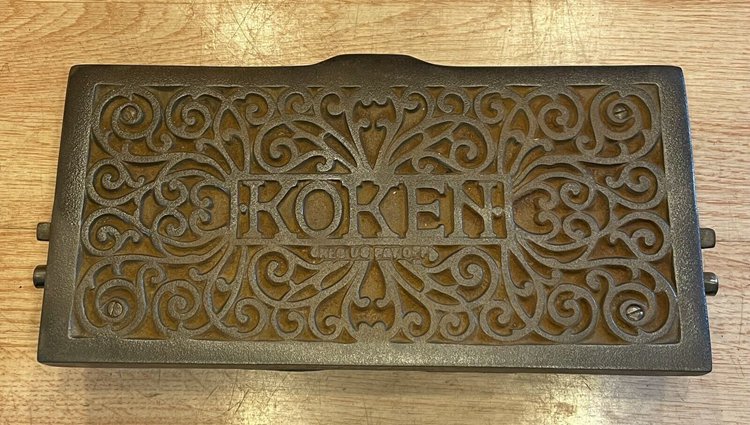
The majority of Koken barber chairs include a serial number stamped on the chair. Look beneath the cushion of the seat you’re sitting on to discover yours. It’s possible that the number is imprinted on the back of the wood, or it might be on the chair frame itself.
Leatherwork
When it came to the construction of the many versions of Koken barber chairs, skilled artisans used only the highest quality materials. In many cases, the seats are upholstered in leather and tufted, the arm and foot rests are cushioned, and the frames are made of quarter-sawn wood or walnut.
Framework
Last but not least, you need to examine the structure of the chair itself, which is hydraulic. Oak, walnut, and many other visually appealing types of wood were used to construct the frames of the vast majority of Koken barber chairs, particularly those manufactured between the years 1890 and 1930.
The frames of subsequent models often consisted of chrome-plated metal instead. These early prototype designs are highly appreciated by current barbers since the majority of the hardwood structure of Koken’s oldest barber chairs was just as finely carved and adorned as the metalwork.
The frames often included ornate wood carvings of various kinds. Even the metalwork on these chairs was decorated in a decorative manner. All of the components, including the seat brackets, elements of the footrest, and the base, have intricately beautiful scroll designs, and the workmanship is of the highest quality.
The operating hydraulic lifts, which were Koken’s claim to fame in the furniture industry, may be found on some of the most precious vintage Koken chairs.
How Much Are Antique Barber Chairs Worth?
Even if it is obvious that the one-of-a-kind barber chairs built by Koken were quite the thing back when they were first introduced, this does not imply that they are no longer in style now. In point of fact, against popular belief, a Koken hydraulic chair in a state of disrepair still has a chance of selling for close to $500.
At an auction, the chair will always bring in a higher price if it is in better shape than when it was brought in. There are, however, certain varieties (or time periods) of Koken barber chairs that are more valuable than others.
Condition
In contrast to several other types of antiques, Koken barber chairs retain their highest value after being restored to their original state. The chair’s value will increase proportionately with how close it comes to being in the “mint” condition.
The chair is in great functioning order, with completely functional hydraulics, immaculate upholstery (in the original design and color), stunning original carvings and metalwork, and no rust or other damage. The chair is in mint condition.
Excellent Condition: The chair is in almost excellent working condition, with fully functional hydraulics, no visible signs of wear and tear to the upholstery, and just a trace amount of rust.
Very Good Condition: The chair is in good functioning order, with operable hydraulics, only little wear-and-tear to the upholstery, and minimum to moderate rust. The condition of the chair is rated as Very Good.
Good Shape: The chair is in generally good condition, although it may need repairs to the hydraulics and other minor to moderate repairs to the upholstery. It also has significant rusting.
Poor Condition: The chair does not function in any way (neither the hydraulics nor the mechanics that allow it to rotate or recline), and it may need considerable re-upholstering as well as the cleaning of rust or other damage.
Era
The age of the chair, in conjunction with the condition it is in at the time of sale, will determine the value that is assigned to it. The value might be more or lower than the original purchase price.
Find the serial number that is affixed to the bottom of the seat cushion, and use it to determine the make and model of the chair.
- Chair was made in the 1880s does not use hydraulics and has intricate wood and metalwork.
- The 1890s presents the first known example of a chair with a unique hydraulic design, with intricate wood and metalwork.
- Chair with an Art Deco-inspired hydraulic design, dating back to 1900–1940 (most valuable and popular)
- Chairs from 1940-1960 Mid-century style hydraulic-design chair (least valuable and popular)
Price of Antique Barber Chairs
It is possible for purchasers to pay anywhere from $500 to $6,000 for a Koken barber chair at an auction. The price paid by buyers will vary based on the chair’s design and its operational condition.
On the other hand, the price range for a Koken barber chair that is in Very Good to Mint condition is between $1,000 and $3,000 on average.
To be more precise, an Art Deco chair from the early 1900s that is in mint condition may get a bid of up to $6,000. On the other hand, chairs from the 1940s and 1950s that are in Very Good condition may only bring you $500 to $1,000.
Market Value of Vintage Koken Barber Chairs
The worth of these chairs may vary anywhere from a few dollars to several thousand dollars, depending on factors such as their age, condition, and special features. They might be as little as a few hundred dollars or as much as six thousand dollars or even more.
Lower Value Antique Barber Chairs
It is possible that a full Koken chair that is in poor condition may sell for less than $500. This is the bottom end of the value range.
A chair in this price category could have considerable corrosion, significant upholstery problems, or badly replaced upholstery, and it would most likely be from the 1940s or the 1950s. It is quite unlikely that it would have intricate carvings or a functional hydraulic lift.
For instance, a Koken barber chair from the 1950s that had not been refurbished fetched around $400 at auction.
Higher Value Antique Barber Chairs
A more desirable Koken chair may get anywhere from $5,000 to $6,000 when it goes on the market. A chair of this sort would be in pristine condition, and it would have a hydraulic lift that really worked, stunning wood carvings, and leather upholstery that was in pristine condition when it was first made.
It was presumably made somewhere between the late 1800s and the Art Deco period. A Koken barber chair from the 1920s that was in good condition sold for around $4,500. It had been meticulously refurbished and was equipped with a functional hydraulic mechanism.
- Antique congress Koken Barber chair (1895 to 1901) – sold for $5500
- Antique Koken Barber chair with leather strap – sold for $4500
- 1897 fully restored Koken Barber chair – sold for $3000
- Antique restored Koken congress hydraulic wooden barber chair – sold for $2300
- Antique Oak Koken Barber chair – sold for $1560
- Vintage Koken Barber chair – sold for $1500
- Antique Koken hydraulic wooden barber chair – sold for $1425
- Antique Koken Barber chair – sold for $1400
- Restored Koken Barber chair – sold for $1300
- Vintage 1930s Koken Barbers – sold for $1034.99
- Vintage Koken Koch porcelain barber chair – sold for $600
- Vintage Koken hydraulic barber chair – sold for $575
Buying Antique Koken Barber Chairs
Red Vinyl & White Enameled Cast Iron Antique Barber Chairs
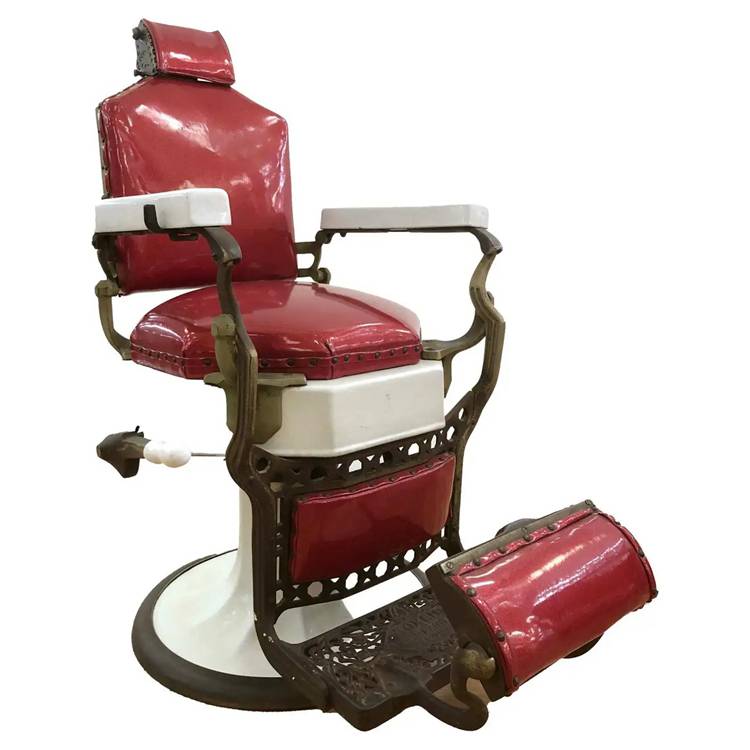
Original antique barber chair featuring rich red vinyl upholstery mounted to a white enameled cast iron frame. Also features a manual pump lever to adjust the seat height. Minor wear on the arms from age and use.
Antique Koken Barber chair
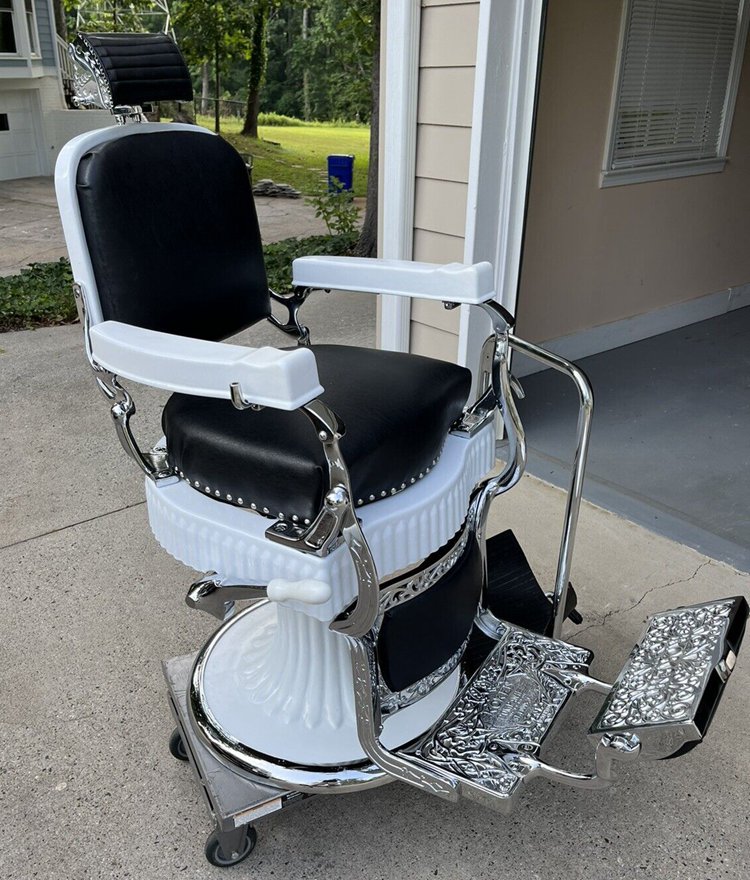
This antique barber chair has an original leather upholstery and metal foot grate, with tufted leather seats. Only the finest materials are used in its production with a porcelain base base.
Antique Early Barber Chair
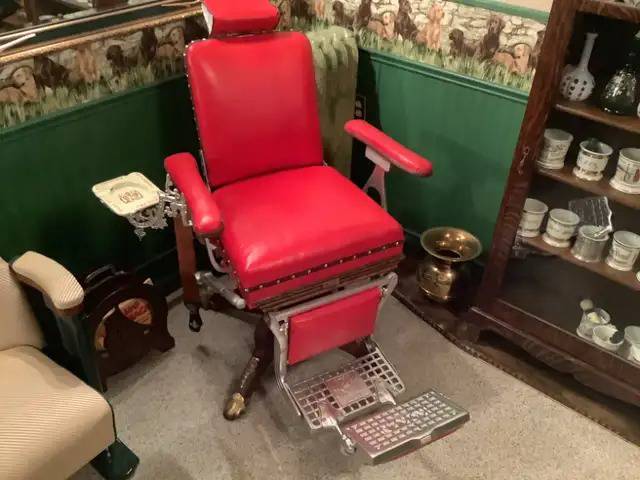
It is a vintage Koken Barber Chair has undergone extensive restoration to return it to its original form. It is made of red weather with leather-covered armrests and headrests.
Antique 1930s Koken Barber Chair
These antique barber chairs from 1930 by Ernest Koken Brand have a leather upholstery with a working hydraulic lift, and a metal foot grate and foot rest. It has elaborate carvings and Koken name depicting high quality craftsmanship.
Vintage Koken Barber Chair
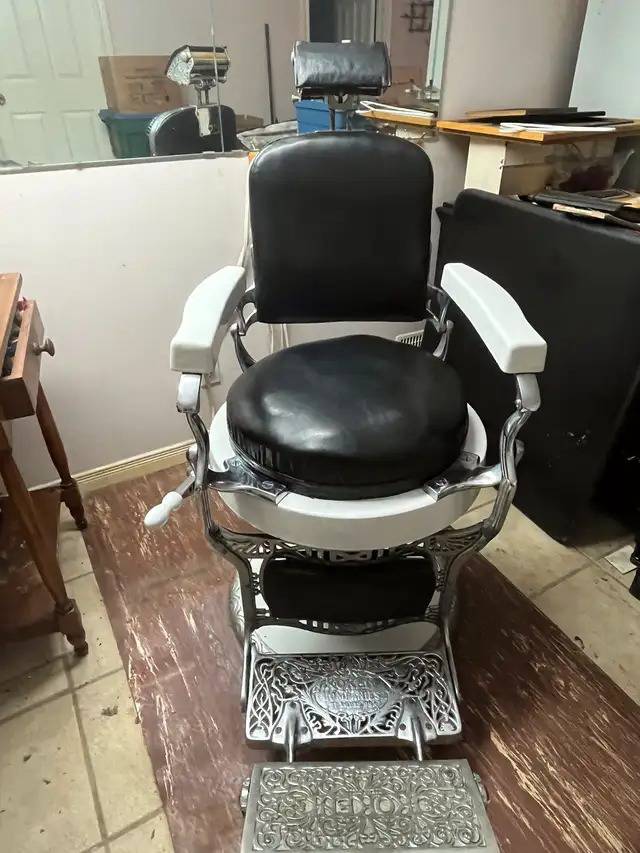
It’s in mint condition with no rust and all hydraulics work. It has original leather upholstery on the seat and back. They are one of the best vintage barber chairs you can come across today.
Rare Antique Koken Octagon Barber Chair
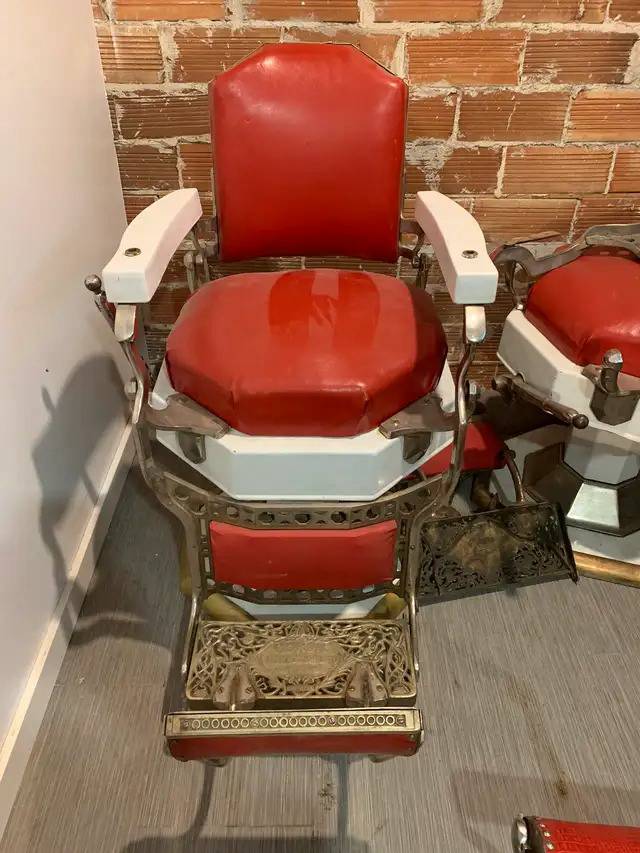
Having a porcelain base, the frames constructed by Koken barber have the best hydraulics work. They feature antiques with wide footrest to support the ergonomics. This is one of a kind octagon vintage barber chair.
Antique Barber Chair Brown Leather & White Porcelain
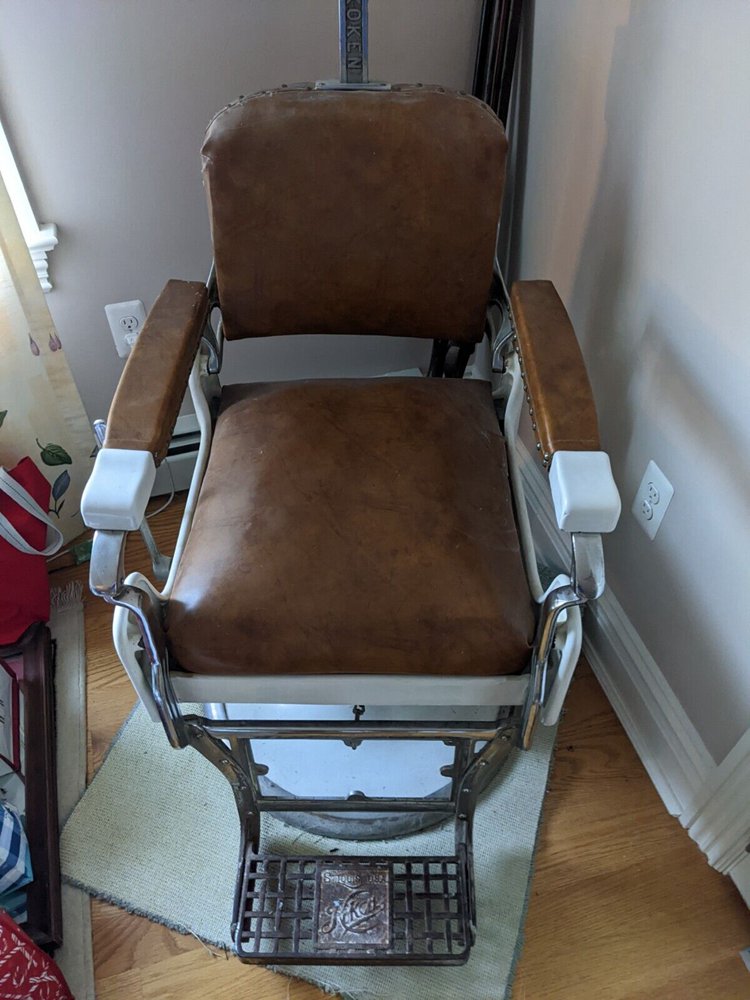
This brown antique barber chair has a working hydraulic lift, with the metal foot rest. It has a padded arm and offer enough comfort, and aesthetic to your barbershop.
Antique Vintage Koken Barber Chair
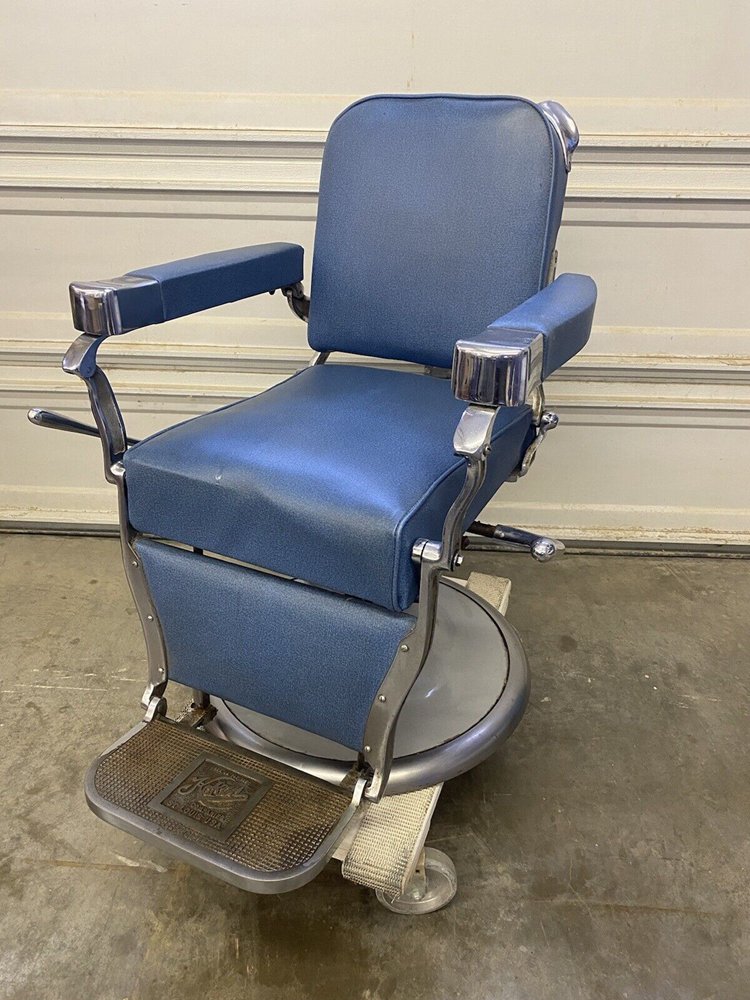
This sort of antique barber chair has padded arms and porcelain base. It has the perfect hydraulic lift and proves to the best antique barber chair around these days.
Locating Retail Outlets That Sell Vintage Koken Barber Chairs
In a barbershop, or even in a private home, a display of antique furniture such as Koken barber chairs is sure to attract attention. Even if they are not very common, there is a possibility that you will be successful in acquiring one if you seek it in the following places:
- Local antique stores
- Websites for online auctions such as eBay and Etsy
- Craigslist, in addition to the classified sections of local newspapers
- The proceeds of antique furniture from the selling of former beauty schools and estates
It is essential to be aware that an antique barber chair may weigh hundreds of pounds. Hence, transporting one of these objects from one region of the nation to another may be prohibitively expensive. You will be able to save money on the expense of transportation if you are able to discover a local pickup choice for purchasing or selling an antique barber chair.
Take Away
The American Dream was a reality for Ernest Koken. He moved to the United States when he was a young lad and eventually became renowned and wealthy thanks to the invention and patenting of a well-known hydraulic chair designed specifically for barbers. It’s amazing how it became the largest barber supply company in the US.
In today’s market, prototype designs and Koken chairs from the Art Deco period that are in mint condition fetch prices in the hundreds of dollars. Be cautious to verify the originality of any chair you want to purchase, sell, or trade before doing so.
A lot of earlier models of complete koken chair present in market have poorly replaced upholstery. However, before local pickup make sure that the barber chair is in fair condition.

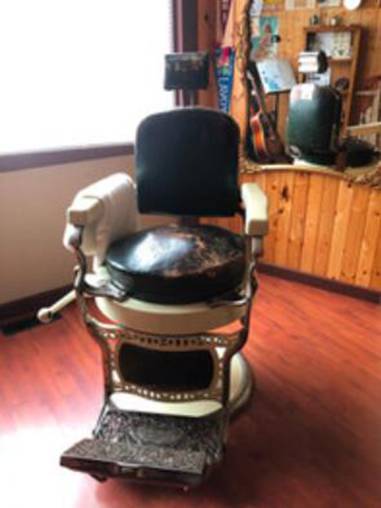




![Where To Sell Antique Furniture In 2022 [Ultimate Guide]](https://www.jacquelinestallone.com/wp-content/uploads/2022/09/Etsy-Your-Place-To-Buy-And-Sell-All-Things-Handmade-600x450.jpg)


